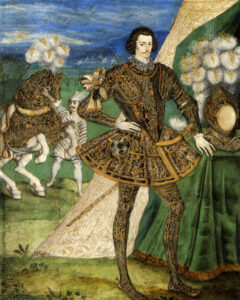On 18th March 1601, soldier, secret agent and rebel Sir Christopher Blount was executed on Tower Hill for high treason.
He was accused of treason following his involvement in the rebellion of his stepson, Elizabeth’s former favourite, Robert Devereux, 2nd Earl of Essex.
Here are some facts about this Tudor chap who came to such as sad end…
- Sir Christopher Blount was born in around 1555/1556, in the reign of Queen Mary I, and was the second son of Thomas Blount of Kidderminster and his mother, Margery Poley.
- Both his grandfather and father had served in the household of John Dudley, Duke of Northumberland, and his grandfather was the cousin of Northumberland’s wife, Jane.
- Blount’s mother, Margery, was a devout Catholic, and was a Catholic recusant in Elizabeth I’s reign. Blount was brought up as a Catholic, receiving education in Louvain from William Allen. He was also educated at Oxford’s Hart Hall and the English College at Douai.
- On his way home from Douai, in late 1576, Blount mixed with supporters of Mary, Queen of Scots, including Thomas Morgan, in Paris. The English ambassador, Sir Amias Paulet warned Blount off them and also reported the contact to Leicester and Elizabeth I’s spymaster, Sir Francis Walsingham
- Blount had entered the service of the Duke of Northumberland’s son, Robert Dudley, Earl of Leicester, by 1584, serving him as his gentleman of the horse while Leicester was the queen’s Master of the Horse.
- In 1585, Thomas Morgan asked Blount to help organise a way for Mary, Queen of Scots to secretly communicate with her supporters on the Continent. Blount responded favourably, but the man he sent to Morgan, Robert Poley, was in fact a secret agent working against Mary, a fact of which Blount was well aware. Poley and Blount were helping ensure that Mary’s correspondence could be monitored.
- Also in 1585, Blount accompanied Leicester to the Netherlands, serving him as a cavalry officer. In 1586, Blount rescued Sir Francis Vere in the Battle of Zutphen after Vere’s horse was killed. He went on to serve as lieutenant, and then captain of the lancers. Blount did not return to England with Leicester, but carried on serving in the Netherlands under Lord Willoughby. In 1588, he injured his hand fighting and was knighted before returning to England in January 1589.
- Leicester died in September 1588 and sometime in Spring 1589 Blount married Leicester’s widow, Lettice Knollys, granddaughter of Mary Boleyn. They knew each other well, due to Blount’s service to Leicester, and the marriage appears to have been a love match and a happy marriage.
- By April 1589, Blount had recovered enough from his hand injury to accompany his new stepson, Robert Devereux, Earl of Essex, on an expedition to Portugal.
- In 1593 and 1597, Blount served as a knight of the shire in Parliament for Staffordshire.
- In 1596, Blount accompanied Essex on his expedition to Cadiz, serving as a colonel and camp master, and also accompanied him to the Azores in 1597.
- Blount also accompanied his stepson to Ireland after Essex was made Lord Lieutenant of Ireland, but was forced to return to England after he suffered a leg injury. Essex got into big trouble with the queen and her council after his failure in Ireland and leaving his post there without her permission. He was put under house arrest.
- Blount tried to persuade Essex to flee abroad into exile, but Essex wouldn’t, and, instead, decided to rebel in what would be the failed Essex’s Rebellion of February 1601. Blount supported him, taking an active part in the rebellion by leading an attack on Ludgate, where he suffered head and facial injuries.
- Following the failure of the rebellion, Blount was put under house arrest at the home of Richard Newsome, a tailor, before being tried for treason. His injuries meant that he had to be carried to his trial on a litter. He was found guilty at his trial at Westminster on 5th March 1601 and condemned to death.
- On the scaffold on Tower Hill on 18th March 1601, Blount professed his Catholic faith before he was beheaded. His remains are thought to have been buried at the Tower of London.
Also on this day in Tudor history...
Image: A portrait of Blount's stepson, Robert Devereux, attributed to Nicholas Hilliard




Leave a Reply